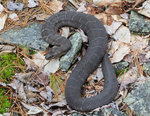 Narrowsburg
NarrowsburgLight Rain Fog/Mist, 43°
Wind: 8.1 mph
 Narrowsburg
NarrowsburgWarmer days came with the month of May—so has something else. The timber rattlesnake is considered a pit viper; it has small pits forward of the eyes, which are used to detect body heat from …
Stay informed about your community and support local independent journalism.
Subscribe to The River Reporter today. click here
This item is available in full to subscribers.
Please log in to continue |


Warmer days came with the month of May—so has something else.

You may have noticed a few more small snakes while walking on trails in the woods or even in your backyard garden or lawn. A wide variety of snake species started emerging in late April, but now with the warmer weather, they are a bit more active. One fairly common sighting is the eastern garter snake, perhaps one to two feet long, or maybe a tiny northern ringneck snake, so small that they could easily coil up in the palm of your hand. These are only a couple of the many species of snakes that populate our region.
Pennsylvania is home to 21 species of snakes, while New York has 17 species. Snakes are commonly found in grass, along trails or roads, or along lake shores or creeks. All but three species of snakes found in both states are non-venomous. Of the three venomous snakes, the only one found in this region is the timber rattlesnake.
Snakes have had a lot of stigma attached to them, perhaps from movies, or the story of St. Patrick chasing the snakes out of Ireland; many people fear snakes, even the little ones. The fact is that most snakes want nothing to do with people and will hide or flee from human contact. Snakes may try to bite if handled, but non-venomous species have teeth so small that only the larger individuals may cause pinprick-size wounds.
Rattlesnake sightings are infrequent, but if you spot one, simply stay away from it (eight feet or better). Chances are you may hear the rattle before actually seeing the snake. This snake rattles when it feels threatened, so make sure to discern where the rattle is coming from and then move away. Rattlesnakes, like other species, would rather flee when given the chance rather than engage with us. Above all, don’t try to handle rattlesnakes—many of the recently recorded rattlesnake injuries involve people who try to pick up or otherwise molest them. More facts and safety tips can be found from the PA Fish and Boat Commission at https://www.thetimberrattlesnake.com/safety.html.
Comments
No comments on this item Please log in to comment by clicking here